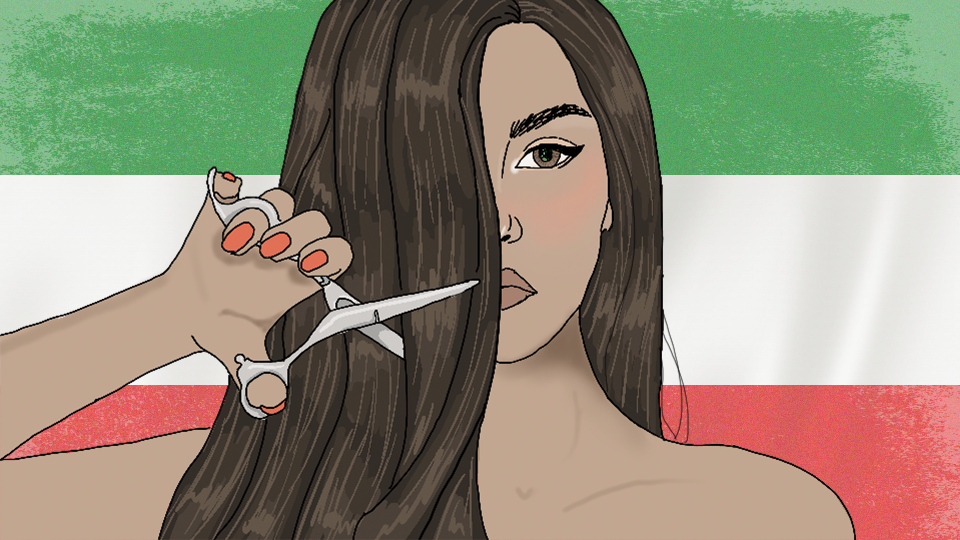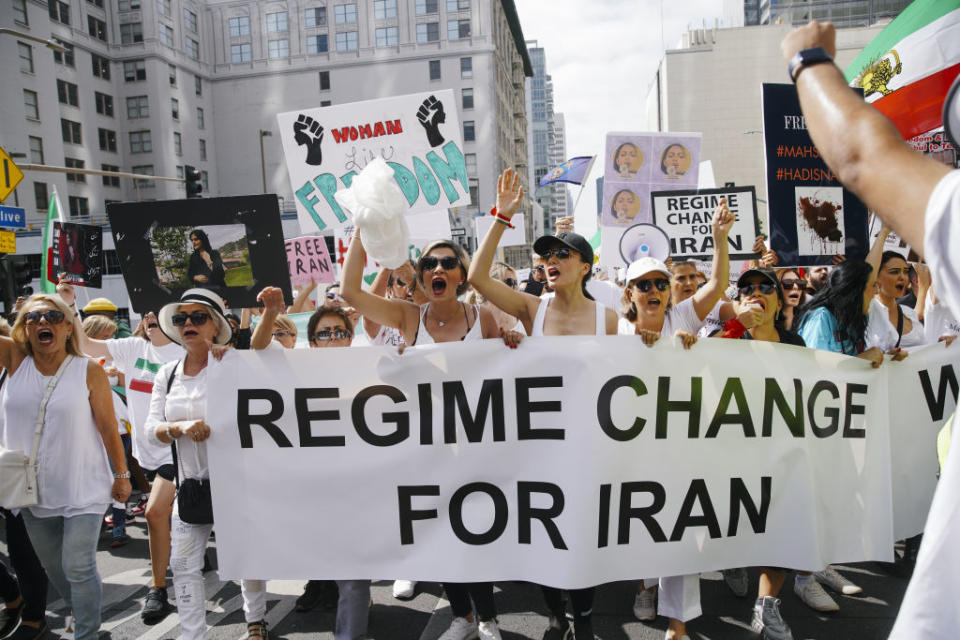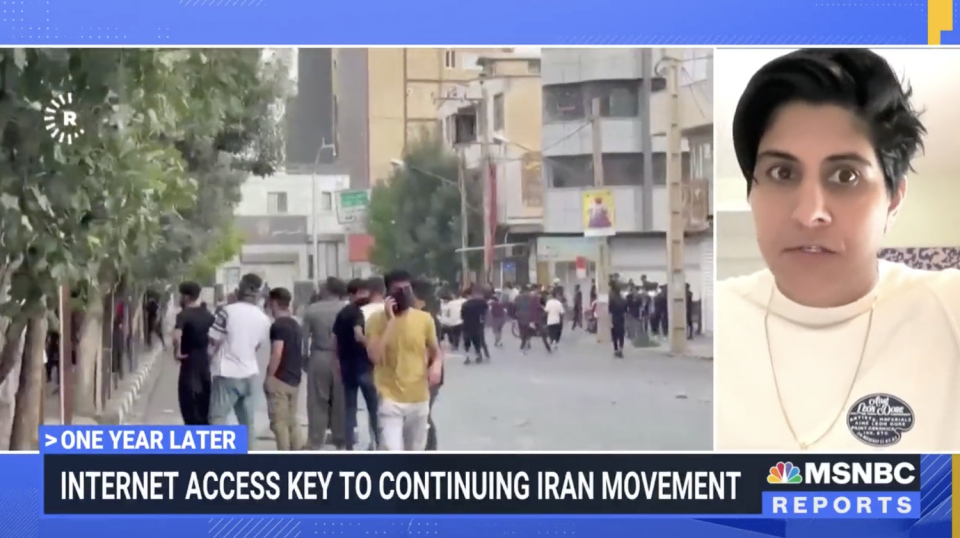How to Help Iran Protests 2023: Stand Up for Women, Life, & Freedom


When I saw photos of 22-year-old Mahsa Amini for the first time, I felt like I was looking at someone who was a part of my family; someone I know without a doubt I would have loved had I known her. It’s a feeling every member of the Iranian diaspora is familiar with. And because the people of Iran desperately need our support and solidarity right now, it’s vital that we talk about how to help the protests in Iran in 2023.
More from StyleCaster
Persian New Year 2023: How to Celebrate Nowruz During Revolutionary Times
How To Help Iran Protests 2023: Stand Up For Women, Life & Freedom
This Cult-Favorite Day Cream with SPF Makes Skin 'Shiny & New'-& It's 40% Off for Cyber Monday
Iranians rarely agree on everything. They often disagree on who’s to blame for the oppression that has gripped Iran like a disease for the past 40 years. They tend to have different opinions about what led to the 1979 revolution that overthrew the Pahlavi dynasty and subsequently replaced it with a regressive and oppressive dictatorship known as the Islamic Republic of Iran. And although there have been several protests in Iran since then, none have taken the world by a storm quite like this. Because of Mahsa Amini, Iranians all over world are united in their fierce determination to bring this brutal regime to an end. Their rallying cry—Women. Life. Freedom (zan, zendegi, azadi).
On October 1, a global call for anti-regime protests was answered. 20,000 people showed up to protest at Pershing Square in Los Angeles, proving that “Tehrangeles” is alive and well. Canadian police estimate that over 50,000 people showed up to march on Redmond Hill in Toronto. Even the brave women of Kabul, Afghanistan have taken to the streets to voice their support for the movement. Thousands have gathered for protests all over Europe and Asia. French actresses Marion Cotillard and Juliette Binoche have cut their hair in solidarity with the women of Iran.

Although I was born in the United States, my mother was born in Kermanshah. She is Kurdish, just like Mahsa Jina Amini was, and she’s been living with survivor’s guilt ever since she escaped to this country as a teenager. Let it be known—I don’t know one Iranian person who’s life hasn’t been impacted by this regime on some level. We’ve lost loved ones to this regime. We have loved ones who are still there, living under the hammer of theocracy and dictatorship. Above all, we have had our country, culture and way of life stolen from us.
As a member of the Iranian-American diaspora, I am used to feeling like no one cares about our people. To see this many people mobilizing in support of my mother’s people gives me a feeling of hope that I’ve never experienced before. No matter what happens, please don’t stop caring. By and large, Iranians feel immense gratitude when you share their stories and show them solidarity. They need to know that we’re with them; that we’re watching, listening and standing with them as this courageous grassroots movement continues to grow.
What Are the Iran Protests About?
On September 12, 2022, a 22-year-old Kurdish woman named Mahsa Jina Amini left her home in the Saqqez province, a region of Iran known as Kurdistan. She was on her way to visit her brother in Tehran, the capital city of Iran. By the time she reunited with her brother on September 13, she had been arrested by what is known as the “morality police” due to a few strands of hair peeking through her headscarf. They took her to a station to be “educated” on the law that requires all women in Iran to keep their hair covered. By September 16, she had fallen into a coma and was eventually pronounced dead. Although the Islamic Republic alleges that she died of a heart attack, Amini’s family claim she had no pre-existing heart problems. However, post-mortem CT scans show signs of skull fractures, hemorrhage and brain injury, painting a very different picture of what happened to her.
By September 17, the first protest erupted during Mahsa Amini’s funeral. Protests have since swept every corner of the country, launching a revolution that has been largely led by protestors born after 2000 (Iran’s Generation Z). Women—some as young as pre-teens—have been burning their headscarves, cutting their hair and chanting “death to the dictator”, uniting them in their shared fury. Images have been circulating of young schoolgirls flipping the bird at the portrait of the Ayatollah Khamenei that hangs in every classroom in Iran. Men have also been at the forefront of these protests, because the demand for regime change did not just happen overnight. It’s the result of a dictatorship that regularly persecutes its own people and denies them the basic human right to self-expression. In Iran, singing and dancing can get you killed. So can being a member of the LGBTQ community. These protests are also taking place in a country with rapidly rising poverty levels and limited opportunities, as US-led economic sanctions against Iran have contributed to a pressure cooker of problems in Iranian society.

These protests have been met with violence at the hands of the Islamic Republic. As of January 27, 2023, 488 people have been killed by security forces in Iran, according to Iran Human Rights (IHR NGO). This also includes 64 children and 39 women. At least 107 protesters are currently at risk of execution, death penalty charges or sentences. Furthermore, at least 55 people have been executed in the first 26 days of 2023. These numbers are likely higher, as these are the only deaths that are confirmed. 15,000 protestors have also been arrested in severe crackdowns and are at risk for imminent execution by the Supreme Leader of Iran for “waging a war against God” (as if Khamenei is on the same level as God). Kurdish regions of Iran are under heavy military siege by the Islamic republic of Iran, as Kurdish civilians are being systematically targeted, kidnapped, arrested and murdered. When an Iranian person attends a protest, they know there’s a chance they won’t make it back home.
Take 16-year-old Nika Shakarami, for example. On September 20, she left home to attend a protest in Tehran and disappeared for 10 days before her parents finally found her body at a morgue. “When we went to identify her, they didn’t allow us to see her body, only her face for a few seconds,” Atash Shakarami—Nika’s aunt—told BBC Persian. Government officials threatened her family and told them not to host a funeral. They later stole Nika’s body, making sure that she was quickly buried in secret and laid to rest far away from home, presumably to prevent her from becoming a martyr. She was supposed to turn seventeen on October 2, the same day her family was finally able to transfer her body back to her father’s hometown of Khorramabad.
How to Help Protestors in Iran
1. Be their voice
Due to massive internet blackouts in Iran and the Islamic Republic severely limiting social media access, international awareness of these protests has been slow to spread. Iranians on the ground have been using VPNs (Virtual Private Networks) to bypass these restrictions to the internet so that they can continue posting about these protests and keeping the world updated on this ongoing revolution.
These internet crackdowns put in place by the Islamic Republic have robbed Iranians of their voice, which means they need the rest of the world to be their voice for them. If you do one thing to provide help to the protests in Iran, let it be this—talk about it. Ask questions and educate yourself. Don’t be afraid to speak up or participate in this movement. As global scrutiny of the protests intensifies, so does the mounting pressure on the Islamic Republic of Iran.

2. Make a donation
Due to U.S. sanctions against Iran, we can’t send money directly to the protestors in Iran. However, here are some notable and reputable organizations that you can donate to:
The Iranian Diaspora Collective—Because mainstream media coverage has been lacking, this coalition of writers, artists, journalists and professionals of the Iranian diaspora seek to invest donated funds into “purchasing advertising (billboards, print media, and digital media) in high-visibility locations.” This will enable them to “accelerate and extend the momentum related to the women-led protests in Iran.” Currently, the IDC is working on “Connectivity Is a Human Right”, which is an initiative to Keep Iran Online by increasing on-the-ground VPN service, supporting the progress of VPN technology, and facilitating innovations in tech infrastructure that will circumvent internet shutdowns in the future. Help Keep Iran Online and create global visibility for what’s going on in Iran by sending a donation.
The Center for Human Rights in Iran (CHRI)—The whole purpose of this organization is to protect and fight for human rights in Iran. They will use funds to document and research all incidences of human rights violations that take place in Iran. You can make a donation here.
The Abdorrahman Boroumand Center—is a non-profit non-governmental non-profit organization dedicated to the promotion of human rights and democracy in Iran. They monitor human rights violations in Iran and make them public knowledge by through research, documentation, publishing and public outreach. You can make a donation here.
3. Attend a protest
Thousands gather in downtown Los Angeles to protest for women’s rights in Iran pic.twitter.com/GuRcPyAXT1
— Brian Feinzimer (@bfeinzimer) October 1, 2022
https://platform.twitter.com/widgets.js
October 1, 2022 was a day of global anti-Iranian government protests all around the world. This is a powerful time to organize, rally and show support by attending a protest in or near your city. Whether you’re simply driving by the protest and honking your horn in solidarity or you’re designing your own poster and chanting with other Iranians, your presence at a protest is always welcomed and appreciated. Although it’s impossible for everyone at a protest to share the same views, rallying together for a uniting cause is incredibly symbolic (and ultimately healing). Together, we can focus on the task at hand—to support the people of Iran and show them that we have their back.
4. Sign a petition to stop executions

There are several petitions you can sign in support of bringing freedom and justice to the people of Iran. Help this important petition to the United Nations reach 1,000,000 signatures by signing it here.
5. Follow Iranian social media accounts
//platform.instagram.com/en_US/embeds.js
The best way to receive up-to-date information about the Iran protests is by following Iranian activists and journalists on social media. Here are a few Instagram accounts to follow:
Iranian Diaspora Collective—an organization dedicated to global visibility for Iran (@iraniandiasporacollective)
Moj—co-founder of the Iranian Diaspora Collective (@moj)
Roya Zahra Rastegar—co-founder of the Iranian Diaspora Collective (@royazara)
Samira Mohyeddin—an Iranian journalist (@smohyeddin)
Style Shah—an Iranian social media influencer & activist—(@styleshah)
1500tasvir—an Iranian activist (@1500tasvir)
Masih Alinejad—an Iranian journalist (@masih.alinejad)
Nazanin Boniadi—an Iranian actress & a member of the CHRI board (@nazaninboniadi)
from: Iran—a feminist coalition of unheard Iranian voices (@from____iran)
Best of StyleCaster

